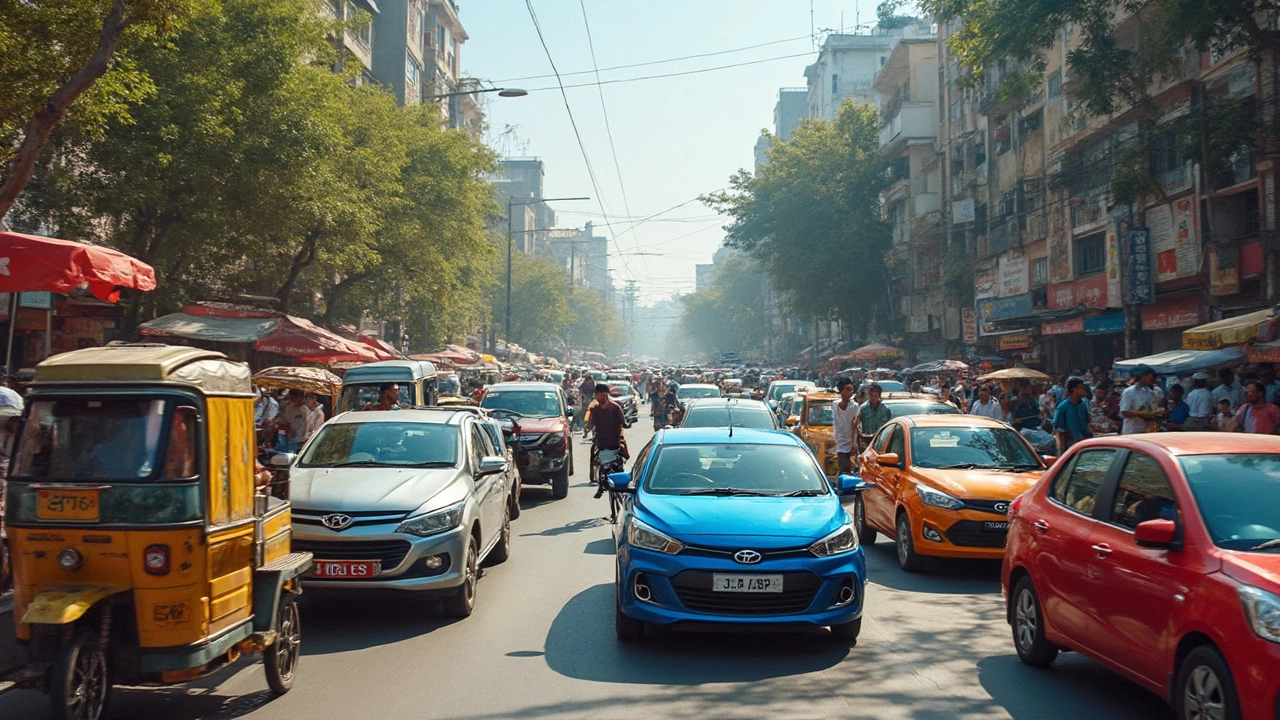Step outside in any city from Delhi to Coimbatore, and you'll notice something about Indian streets: there’s a sea of familiar compact cars threading through traffic jams and narrow lanes. You might guess that the Maruti Suzuki is everywhere, and honestly—you’d be spot on. But what drives this loyalty? Price, fuel economy, easy repairs—everybody wants those. Even my son Arjun can spot the difference between a WagonR and a Swift from two blocks away, so these cars are practically part of the family for many Indians.
The numbers don’t lie. Maruti Suzuki models have led the sales charts for years, sometimes snapping up six out of the top ten spots in monthly rankings. There’s a reason grandma, college kids, and office commuters are often behind those wheels. Understanding why these models work so well isn’t just about sales—it’s about how they fit the country’s roads, wallets, and daily routines. If you’re thinking about which car actually moves India, you’re about to get some straight answers, packed with real-world insights and tips you can actually use.
- What Defines 'Most Driven' in India?
- Maruti Suzuki: The Giant Everyone Knows
- The Hatchback Phenomenon and Why It Works
- Rising Stars: SUVs and Compact SUVs
- What Real Car Owners Say: Surprising Factors Behind the Pick
- Tips for First-Time Car Buyers in India
What Defines 'Most Driven' in India?
If you want to figure out what the most popular car India drives, you can't just look at flashy ads or the latest launches. What matters is what's actually on the road: the all-time best-sellers, the cars packed into apartment parking lots, and the models racking up kilometers every single day.
In India, "most driven" comes down to a mix of things:
- Yearly and monthly sales numbers—who’s selling the most right now?
- Total number of a model registered across the country
- How often you see the car being used as daily transport—by families, cab drivers, and delivery folks
- How these cars hold up in the resale market and what mechanics see most often in their repair shops
Let’s talk straight numbers for a second. Here are the top-selling passenger vehicles in India for the financial year 2023-24, according to SIAM (Society of Indian Automobile Manufacturers):
| Rank | Model | Brand | Units Sold (2023-24) |
|---|---|---|---|
| 1 | WagonR | Maruti Suzuki | 188,104 |
| 2 | Swift | Maruti Suzuki | 174,061 |
| 3 | Brezza | Maruti Suzuki | 164,624 |
| 4 | Baleno | Maruti Suzuki | 157,567 |
| 5 | Ertiga | Maruti Suzuki | 148,170 |
The top five spots all go to Maruti Suzuki, and there’s a good reason for it: their cars just work for Indian families. You get solid fuel efficiency, easy repairs, and no-nonsense pricing. If you check your own neighborhood or the lineup of cabs at an airport, chances are you'll see these models first.
What really sets these "most driven" cars apart isn’t just what’s on paper—it’s how well they match everyday needs. Indian families value cars that squeeze into tiny parking spaces, handle bumpy roads, and are cheap to fill up. As a result, compact hatchbacks and small SUVs skyrocket past bigger or flashier models in popularity.
And here’s one more tip: when you’re deciding what to buy, watch which cars keep showing up in traffic jams and carpool groups. That’s the secret sign of a "most driven" car in India.
Maruti Suzuki: The Giant Everyone Knows
If you ask anyone in India about the car they grew up seeing or even learning to drive in, Maruti Suzuki tops the list. For the last two decades, this brand has been everywhere—probably in your neighbour's garage, your friend’s first car, or the one you hire for trips out of town. Maruti Suzuki isn’t just another company; it’s the backbone of car ownership for millions.
The simple reason? It’s practical. Maruti Suzuki’s models are made for Indian conditions—bumpy roads, traffic, and sudden rain. Their cars are cheap to maintain, easy to fix, and run reliably for years. Local dealers are present in almost every city and small town, so getting spare parts or a repair job is never a big headache. This matters when you’re using your car daily or even squeezing five people into a hatchback for a family wedding.
Let’s talk numbers. Every year, Maruti Suzuki sells well over 1.5 million cars here, grabbing about 40% of the Indian car market. That's bigger than any other brand by a huge margin. If you walk into a dealership, chances are the most popular car India buys is painted across their showrooms—the Swift, Alto, Baleno, Dzire, and WagonR keep clocking up massive monthly sales.
What makes these models hit the sweet spot?
- They’re fuel-efficient—crucial with today’s petrol prices.
- Resale value holds up, so selling your old Maruti isn’t a pain.
- Their price tags fit a wide range of budgets, with good entry-level options for first-timers and families on a budget.
- Features are simple and user-friendly: you get just what you need, no overcomplications.
Another fun fact: Maruti Suzuki set up India’s first true mass car production line way back in the 1980s. The Maruti 800, launched in 1983, got thousands of Indians moving away from scooters to cars. Even today, you’ll spot Maruti 800s still chugging along in smaller towns. The brand has made sure owning a car is possible for the average Indian, not just the wealthy.
If you’re thinking about picking up a car that’s reliable, low-cost to run, and super easy to sell later, Maruti Suzuki sits right at the top of the shortlist. With so many on the road, you’re always just a phone call away from a mechanic who knows what they’re doing.
The Hatchback Phenomenon and Why It Works
If you look at the Indian car scene, hatchbacks are kings. They’re not just everywhere—they’re most folks’ first pick. There’s a good reason for it. Indian cities are famous (or infamous) for tight parking, crazy traffic, and narrow roads. Hatchbacks tackle all of that with their small size and easy handling. You can squeeze them into parking spots that even auto-rickshaws avoid.
The price tag is another big pull. Most hatchbacks fit right into the budget of middle-class families and first-time buyers. Take the Maruti Suzuki Alto, WagonR, and Swift. These names probably sound familiar because they’ve hogged the top spots in sales year after year. Not to mention the Hyundai i10 and Tata Tiago have their own fan clubs.
Why do people really go for hatchbacks? Well, here’s what matters most:
- Lower price means smaller loans or even full cash payment for many buyers.
- Excellent mileage—even basic petrol hatchbacks can hit 22-24 km/l under the right conditions.
- Maintenance is a breeze. Mechanics in every corner know how to fix them, and parts are cheap.
- Resale value is high. When it’s time for an upgrade, you get a good chunk back.
Don’t just take my word for it. Here’s how some of the top hatchbacks did last year (2024):
| Model | Units Sold (2024) | Starting Price (INR, ex-showroom) |
|---|---|---|
| Maruti Suzuki Alto | 2,83,000 | 3.54 lakh |
| Maruti Suzuki WagonR | 2,49,000 | 5.54 lakh |
| Maruti Suzuki Swift | 1,96,000 | 6.49 lakh |
| Hyundai Grand i10 | 72,000 | 5.92 lakh |
| Tata Tiago | 64,000 | 5.65 lakh |
Notice how all these top sellers fall in a sweet spot of price and easy ownership. That’s why, when someone talks about the most popular car India drives, you’ll almost always see a hatchback in the picture.
The last point? Upkeep. My cousin’s Alto is over a decade old and still going strong because he can fix almost everything himself. The hatchback story isn’t just about numbers; it’s about real-world practicality that fits Indian life perfectly.

Rising Stars: SUVs and Compact SUVs
When you think about what car Indians drive the most these days, it’s not just about the small hatchbacks anymore. Over the last few years, SUVs and compact SUVs have gone from being just a dream for the average family to a common sight in every city and even in small towns. These vehicles are everywhere, from Kerala’s hills to Mumbai’s expressways.
Why are Indians suddenly loving SUVs and compact SUVs? Simple: bigger looks and a bit more ground clearance—so you don’t scrape the belly on bad roads or monster speed breakers. Then there’s the usual: more boot space for luggage, and that feeling of commanding the road (which honestly, everyone enjoys).
Car companies have caught on to this trend real quick. Tata, Hyundai, Maruti Suzuki, Kia, and Mahindra all rushed in with smaller-sized SUVs that fit urban life and budgets. The most popular car India buyers ask for in this category? Models like the Maruti Suzuki Brezza, Hyundai Creta, Tata Nexon, and Kia Seltos keep flying off the showroom floors.
Check out these official numbers from 2024 showing how much Indians love these rides:
| Model | Units Sold (2024) | Main Appeal |
|---|---|---|
| Hyundai Creta | 160,732 | Stylish, loaded features |
| Maruti Suzuki Brezza | 145,388 | Reliable, fuel efficient |
| Tata Nexon | 144,155 | Safety, tough build |
| Kia Seltos | 111,854 | Premium look, solid tech |
Now, there’s no pretending—these aren’t the cheapest cars out there. But the typical Indian buyer is stretching budgets a bit for better comfort, a taller driving position, and the chance to carry family plus extra stuff for holidays or hometown visits. Even new drivers like my cousin pick compact SUVs for the peace of mind that comes with extra safety features (like six airbags and strong crash-test ratings on the Tata Nexon).
If you’re trying to decide between a hatchback and a compact SUV, here are a few quick tips:
- If you face rough roads a lot, the extra clearance is a game-changer.
- Many SUVs now come with automatic gearboxes, which is a real stress-buster in daily city traffic.
- Watch the mileage: these vehicles weigh more, so fuel costs might go up compared to typical hatchbacks.
- Check what matters more to your family—boot space, seat comfort, or that larger-than-life road presence.
The bottom line: The SUV trend isn’t a passing phase. If anything, car companies are betting bigger every year on this segment, offering better technology, more affordable trim options, and fancier designs to tempt buyers who want a mix of style and practicality.
What Real Car Owners Say: Surprising Factors Behind the Pick
Ask five Indian car owners why they chose their ride, and you’ll probably get five totally different answers. Some decisions sound logical—fuel efficiency, resale value, good after-sales service. But get people talking, and you’ll hear about family traditions, neighbor recommendations, and those moments when the local mechanic gives a thumbs-up. People here trust the advice of friends and relatives more than Instagram ads. It's amazing what sways a buyer's mind right before signing the papers.
Interestingly, for many, it all boils down to the total hassle—or lack of it. My cousin Ramesh told me he picked his WagonR just because the service center was two streets away. No kidding! Convenience isn’t just about cup holders or Google Maps; it’s knowing your neighborhood mechanic keeps spare parts in stock. That confidence trumps a lot of glossy features or the latest design changes.
You’d think safety would be the top thing people look for, but price comes first for most families. Take the amount folks are willing to spend: the sweet spot for new car buyers tends to be between ₹6-10 lakh. Extra features like rear parking sensors, touchscreen displays, or even sunroofs usually come second unless there’s a festival offer that makes them irresistible.
| Factor | Percentage of Buyers Who Value It |
|---|---|
| Fuel Efficiency | 68% |
| Price | 84% |
| Low Maintenance | 59% |
| Easy Resale | 47% |
| Brand Trust | 66% |
Brand loyalty to most popular car India brands like Maruti Suzuki, Hyundai, and Tata doesn’t come out of thin air—it’s built case by case, neighbor by neighbor. You’ll find plenty of owners sticking to the same brand for decades because, as one Mumbai taxi driver put it, “Why mess with what just works?”
- Don’t underestimate influence from word of mouth—friends’ stories about breakdowns or free accessories matter a lot.
- Family needs dominate, like enough space for three kids and two grandparents, plus a dog during holidays.
- Running costs, not just the price tag in the showroom, are a real deal-breaker. People calculate how far they’ll get on a litre of petrol.
- SUVs may look cool, but in small towns, hatchbacks rule because you actually have space to park them.
At the end of the day, owning a car in India is partly about enjoying the drive, but mostly about avoiding stress: service hassles, sudden repair bills, or the worry of getting stuck far from home. The real deciding factors aren’t always obvious—sometimes, it really just comes down to what’s parked next door or which brand got grandpa to the temple on time for ten years straight.
Tips for First-Time Car Buyers in India
Navigating the Indian car market can feel a bit overwhelming if you're doing it the first time. So here’s what you really need to look out for—no sugarcoating, just the real stuff you'll thank yourself for knowing later.
The biggest name on the street is Maruti Suzuki, and their dominance isn’t random. Their models are the most popular car India shows off, especially for newbies. Parts are easy to find, service costs are low, resale value holds up, and almost every mechanic knows how to fix one.
But don’t just zero in on popularity. Think about what fits your family, where you’ll drive most, and your regular expenses. Here’s a breakdown of what really matters:
- Budget Wisely: Don’t blow your savings just to get something fancy. Include insurance, loan EMIs, registration, accessories, and regular maintenance. Incidental costs like parking fees and fuel price hikes sneak up on you.
- Petrol, Diesel or CNG? Petrol cars usually cost less up front and are lighter on the wallet for city runs. Diesel gives better mileage for long drives but costs extra on maintenance. CNG models are cheaper to run if you stick to urban areas, but finding stations outside metros is tough.
- Hatchback vs. SUV vs. Sedan: For most first-timers, hatchbacks are easier to park, offer good mileage, and won’t break the bank. If you're into road trips or have a big family, compact SUVs like Hyundai Venue or Tata Nexon are picking up serious traction.
- Safety First: Don’t compromise here. Go for cars rated at least 3 or 4 stars by Global NCAP. Models like Tata Punch and Mahindra XUV300 have made headlines for strong safety scores.
- Low Maintenance Makes Life Easy: Maruti, Hyundai, and Tata score big for their affordable service networks. Check online forums for real owner reviews to avoid buying into a headache.
Check out this snapshot comparing maintenance and mileage averages for top entry-level models:
| Model | Average City Mileage (km/l) | Annual Maintenance Cost (₹) | Starting Price (ex-showroom) (₹) |
|---|---|---|---|
| Maruti Suzuki WagonR | 21 | 6,000 | 5,84,000 |
| Hyundai Grand i10 Nios | 20 | 7,000 | 5,92,000 |
| Tata Punch | 18.5 | 7,000 | 6,12,000 |
| Renault Kwid | 22 | 5,500 | 4,69,000 |
A couple of quick pro-tips: Always test drive more than one car. Take someone with experience along—sometimes you miss details when you’re too psyched. Don’t skip reading that long insurance policy document. And keep an eye out for special seasonal offers from dealers. That extra cash saved can go into your first road trip snacks or a better stereo system!
If you plan to resell within five years, stick with mainstream models. They lose the least value and you'll find buyers fast. There’s no shame in starting practical and upgrading later, once you really know what you want out of a car.









Write a comment